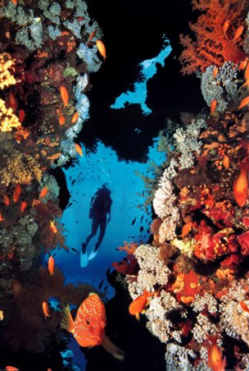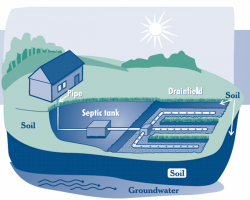Coral Reef Degradation

Scuba Diver Enjoying the Coral Reef Diversity
Coral reef degradation is a significant problem throughout the world. Currently, 27% of the world’s reefs have been affected. Of this, 11% have been completely lost as the other 16% of the reefs have been damaged severely (Gardener, 2003). With these declining rates, the diversity of both plants and animals that rely on the reefs are rapidly decreasing as well. Some of the threats to the coral reefs include wave disruptions, global warming, and human activity such as development along the coast, land-based pollution, and over fishing. These threats impact the coral reef’s ability to grow and reproduce, increase the chances of disease in the coral, and eventually lead to a loss of the coral (Downs, 2005).
Coral reefs are also a big part of our economy. Goods and services such as commercial fishing and scuba diving excursions that come from the coral reefs are worth more than $375 billion dollars annually (Pandolfi, 2005). Out of the total $375 billion, tourism that is centralized around the reefs accounts for an annual revenue of $1.6 billion (Pandolfi, 2005). Therefore, doing nothing to restore the coral reefs is not an option. With the continuing decrease of coral reefs, the world’s economy will suffer as well as its ecosystem.
In the Caribbean alone, with a decrease of 80% over the last three decades, the coral reef coverage has dramatically changed, causing negative effects on the ecosystem (Gardener, 2003). These declines are directly related to human interferences. The amount of the coral reefs that is estimated to have been impacted by human activities is up to 97% (Lipp, 2002). The two main human impacts in the Florida Keys are the amounts of runoff and wastewater that flow into the Caribbean basin and also the amount of recreational and commercial fishing.
Especially in the Keys, human pollution is affecting the coral reefs. Along with being a human health risk and risk to the swimmers, wastewater is an issue impacting the corals. A study at the University of South Florida showed quantitative amounts of wastewater indicators in the coral surface microlayers (CSM). These microlayers are layers of mucus that cover the top few millimeters of the coral. Indicators of human feces bacteria were found in 93.3% of the CSM samples (Lipp, 2002). This is clear evidence that runoff from the local areas is a factor in the reef degradation. Wastewater impacts the coral by reducing the water quality and increasing the algae populations. This wastewater comes from various local sources in the Keys. Most wastewater from the urban cities in Southern Florida seeps into the coastal water from septic system and cesspool effluent (Downs, 2005).
Coral reefs are also a big part of our economy. Goods and services such as commercial fishing and scuba diving excursions that come from the coral reefs are worth more than $375 billion dollars annually (Pandolfi, 2005). Out of the total $375 billion, tourism that is centralized around the reefs accounts for an annual revenue of $1.6 billion (Pandolfi, 2005). Therefore, doing nothing to restore the coral reefs is not an option. With the continuing decrease of coral reefs, the world’s economy will suffer as well as its ecosystem.
In the Caribbean alone, with a decrease of 80% over the last three decades, the coral reef coverage has dramatically changed, causing negative effects on the ecosystem (Gardener, 2003). These declines are directly related to human interferences. The amount of the coral reefs that is estimated to have been impacted by human activities is up to 97% (Lipp, 2002). The two main human impacts in the Florida Keys are the amounts of runoff and wastewater that flow into the Caribbean basin and also the amount of recreational and commercial fishing.
Especially in the Keys, human pollution is affecting the coral reefs. Along with being a human health risk and risk to the swimmers, wastewater is an issue impacting the corals. A study at the University of South Florida showed quantitative amounts of wastewater indicators in the coral surface microlayers (CSM). These microlayers are layers of mucus that cover the top few millimeters of the coral. Indicators of human feces bacteria were found in 93.3% of the CSM samples (Lipp, 2002). This is clear evidence that runoff from the local areas is a factor in the reef degradation. Wastewater impacts the coral by reducing the water quality and increasing the algae populations. This wastewater comes from various local sources in the Keys. Most wastewater from the urban cities in Southern Florida seeps into the coastal water from septic system and cesspool effluent (Downs, 2005).

Septic System
The main cause of this sewage leakage is due to the water level elevations in the Keys. The highest elevation in the Florida Keys is 14ft above sea level. This causes the water table to be very low in most of the region. With this high water table, the septic systems do not work properly in successfully treating the wastewater. Septic tanks and cesspools rely on the soil to treat the sewage. While the water percolates through the soil, microbes in the soil treat the water. This treated water then recharges the groundwater supply, or in this case, flows into the coastal waters. With a drainage length that is too short to have adequate amount of microbe treatment, raw sewage is released into the coastal waters.
In the Florida Keys, coral reef degradation is a problem that needs to be addressed and actions need to be made. Humans are in adversely affecting the coral in various ways such as septic effluent, overfishing, and coastal development. The loss of these reefs will continue to affect the world’s economy and the ocean’s ecosystem if no action is taken in this hard hit area.
In the Florida Keys, coral reef degradation is a problem that needs to be addressed and actions need to be made. Humans are in adversely affecting the coral in various ways such as septic effluent, overfishing, and coastal development. The loss of these reefs will continue to affect the world’s economy and the ocean’s ecosystem if no action is taken in this hard hit area.
